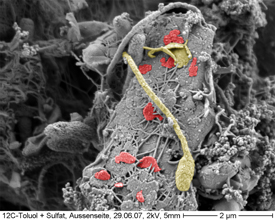Research question 4:
How frequent and
efficient are biology practical classes Conducted?
TABLE V: Frequency and Efficiency of Biology practical classes
|
S/N
|
Item statement
|
No of respondents
|
A
|
A%
|
D
|
D%
|
|
1.
|
Frequency of practical classes:
|
|
|
|
|
|
|
(a)
|
Once in a week
|
100
|
0
|
0
|
100
|
100
|
|
(b)
|
Once in two weeks
|
100
|
0
|
0
|
100
|
100
|
|
(c)
|
Once in a month
|
100
|
10
|
10%
|
90
|
90
|
|
(d)
|
Once in a term
|
100
|
10
|
10%
|
90
|
90
|
|
(e)
|
Once in a while
|
100
|
30
|
30%
|
70
|
70
|
|
(f)
|
Not at all
|
100
|
50
|
50%
|
50
|
50
|
|
2.
|
Demonstration of practical exercises:
|
|
|
|
|
|
|
(a)
|
Done by individuals
|
100
|
10
|
10
|
90
|
90
|
|
(b)
|
Done in groups
|
100
|
30
|
30
|
70
|
70
|
|
(c)
|
Done by the teachers only
|
100
|
60
|
60
|
40
|
40
|
|
3
|
Discussion of exercise and results after demonstration:
|
|
|
|
|
|
|
(a)
|
Consistently
|
100
|
21
|
21
|
79
|
79
|
|
(b)
|
Inconsistently
|
100
|
76
|
76
|
24
|
24
|
|
(c)
|
Once in a while
|
100
|
25
|
25
|
75
|
75
|
|
(d)
|
Not at all
|
100
|
72
|
72
|
28
|
28
|
100% disagree to once in a week and
once in two weeks: 10% agree to once in a month and once in a term. While 90%
disagree. 30% agree to once in a while, while 70% disagree. 50% agree to not at
all, while 50% disagree. As for who demonstrates the practical exercise, 10%
agree that it is done by individuals, while 90% disagree. 30% agree that it is
done by groups, while 70% disagree. 60% agree that it is done by the teacher,
while 40%disagree.
Discussion of exercises and results
after demonstrations was responded to as follows:
10% agree to consistently, while 90% disagree.
20% agree to not consistently, while 80% disagree. 30% agree to once in a
while, while 70% disagree. 40% agree to not at all, while 60% disagree.
It shows from the analysis so far
that biology practical classes are not frequent and efficient, students are not
participating enough and the knowledge gotten through practical are not
adequate in many schools.
Research question 5:
How well are the schools provided
with infrastructural facilities?
Table VI: How well
are the schools provided with infrastructural facilities
|
S/N
|
Item statement
|
No of respondents
|
A
|
A%
|
D
|
D%
|
|
1
|
Adequate
|
100
|
23
|
23
|
77
|
77
|
|
2
|
Inadequate
|
100
|
62
|
62
|
38
|
38
|
|
3
|
Not serious
|
100
|
81
|
81
|
19
|
19
|
|
4
|
No Interest at all
|
100
|
35
|
35
|
65
|
65
|
Table 6 reveals that 23% agree that
provision of infrastructural facilities to the school by the government is
adequate while 77% disagree. 62% agree that it is inadequate, while 38%
disagree. 81% agree that the government is not serious while 19% disagree. 35% agree
that government does not show interest at all while 65% disagree.
From the analysis so far,
it can be seen that government provides infrastructural facilities to the
schools, but the provision is inadequate. Effective teaching and learning can
not take place without the required infrastructural facilities. From the
analysis of the result made in this chapter, the factors militating against the
effective teaching of biology include:
v Lack of qualified and motivated
biology teachers.
v Non use of appropriate teaching methods and
techniques in teaching biology.
v Lack of adequately equipped biology
laboratories.
v Infrequent and inefficient biology
practical classes.
v Inadequate provision of infrastructural
facilities.


No comments:
Post a Comment